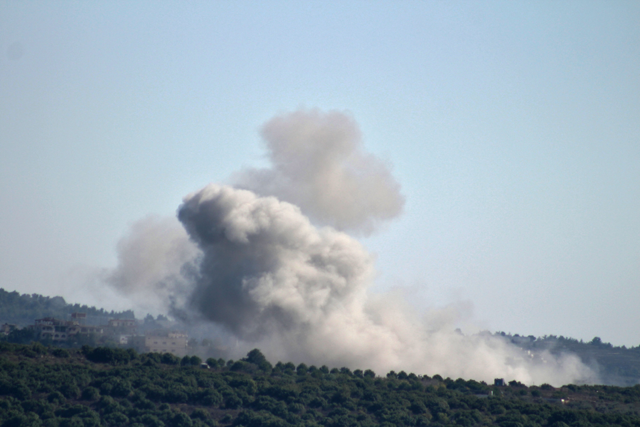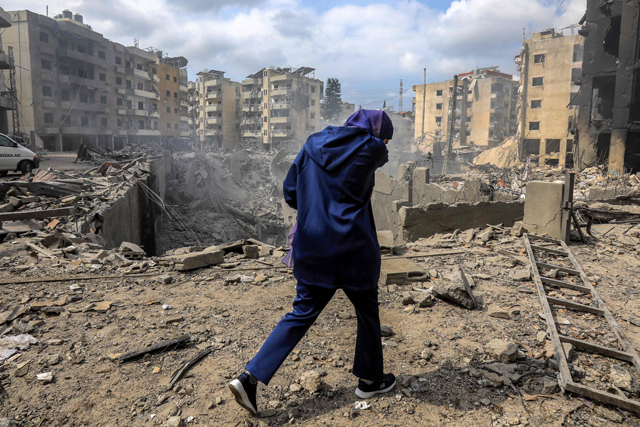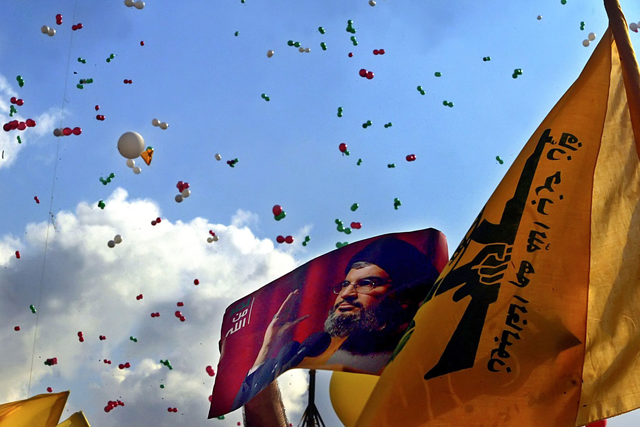You are here
Almost 400 Hizbollah members dead in 10 months of Israel clashes
By AFP - Aug 15,2024 - Last updated at Aug 15,2024

Smoke billows from the site of an Israeli airstrike in the southern Lebanese village of Chihine near the border with Israel on August 13, 2024, amid ongoing cross-border clashes between Israeli troops and Hezbollah fighters (AFP photo)
BEIRUT, Lebanon — Ten months of cross-border violence between Hizbollah and Israeli forces has killed senior commanders and several hundred fighters from the Iran-backed group, causing destruction and displacing tens of thousands on both sides.
Hizbollah has seen more fighters killed since October than when it last went to war with Israel in the summer of 2006.
AFP looks at the mounting toll for the Shiite Muslim movement, which has been trading near-daily fire with the Israeli army in support of Hamas since the Palestinian militant group's October 7 attack on Israel triggered the Gaza war.
Commanders killed
Israeli strikes have killed key Hizbollah commanders in recent months, the most senior of them top operations chief in south Lebanon Fuad Shukr, who died in a raid on Beirut's southern suburbs on July 30. Hizbollah has vowed to respond to his killing.
In January, a commander in Hezbollah's elite Radwan Force, Wissam Tawil, was killed in an Israeli strike on his vehicle in south Lebanon.
Two out of its three area commanders in south Lebanon have also been killed -- Mohammed Nasser and Taleb Abdallah.
Hizbollah divided its operations in south Lebanon into three areas following the 2006 war, each with its own "military formation, commander, personnel, weapons and capacities", the group's chief Hassan Nasrallah said last month.
He said south of the Litani river comprised two areas: a western sector, covered by Hezbollah's Aziz unit, and an eastern sector running to the contested Shebaa Farms manned by the group's Nasr unit, which opened Hezbollah's cross-border attacks in October.
The third sector, north of the Litani river up to the coastal city of Sidon, is covered by the group's Badr unit.
Aziz unit commander Nasser was killed in an Israeli strike last month, while Nasr unit commander Abdallah was killed in a raid the month before.
Israel has repeatedly said it has killed other Hezbollah fighters whom it has called "commanders".
Dead fighters
The violence has killed some 570 people in Lebanon, most of them fighters from Hizbollah but also including dozens from allied armed groups including Hamas, according to an AFP tally, with at least 118 civilians among the dead.
On the Israeli side, including in the annexed Golan Heights, 22 soldiers and 26 civilians have been killed, according to military figures.
Hizbollah has issued statements announcing the deaths of more than 370 members who have been killed in Lebanon, according to the AFP tally.
The Lebanese group has mostly described them as "martyred on the road to Jerusalem", the phrase it uses to refer to those killed in Israeli strikes.
Another 25 have been killed in neighbouring Syria, where Israel has for years carried out strikes on army positions and pro-Iran fighters, also seeking to cut off Hezbollah supply lines to Lebanon from Tehran.
According to the statements, around 320 of the slain Hizbollah fighters were from south Lebanon, with some 60 from the eastern Bekaa Valley, which borders Syria.
Several south Lebanon villages close to the Israeli border each count around a dozen slain fighters, the statements have indicated.
Around 70 per cent of the more than 230 fighters killed since late January, when Hezbollah began to provide the year of birth on its death statements, were aged 40 or under.
At least six were aged 20 or under, with three born the same year as the 2006 war or after it.
A source close to Hizbollah, requesting anonymity, told AFP that fewer than 300 fighters from the group were killed in the 2006 conflict.
Hizbollah operations
Hizbollah has said it is seeking to tie up Israeli military resources in the country's north in support of ally Hamas.
The escalating attacks have raised fears of a broader conflict, and Lebanon has been on edge since Shukr's death.
Earlier this month, the heavily armed group said it had carried out 2,500 "military operations" against Israel since October.
It claimed to have targeted "border positions" 1,328 times and "military barracks" 391 times, using a variety of weapons including artillery, rockets, "guided missiles" and "air defence weapons".
The group has also released three videos purportedly showing surveillance drone footage taken by the group across the border, widely viewed as a potential bank of targets in case of all-out war.
The footage includes aerial images of military positions in northern Israel and the annexed Golan Heights, as well as sensitive areas in and around the port city of Haifa.
Related Articles
BEIRUT, Lebanon — Lebanese official media said Israeli aircraft again bombed Hezbollah's south Beirut bastion on Monday, later reporting six
Beirut, Lebanon — Israel's killing of Hassan Nasrallah leaves Hizbollah under huge pressure to deliver a resounding response to silence susp
TEHRAN — Iran on Monday praised the drone and missile assault by Lebanon's Hezbollah group on Israel, saying its arch-foe had lost the abili














